Control Method of Four Wire Active Power Filter Based on Three-Phase Neutral Point Clamped T-Type Converter
Abstract
1. Introduction
2. Control of Active Power Filter
2.1. Calculation of APF Reference Currents
- The algorithm should be fast, i.e., the calculations should not take much time due to the delay in the control system—it is necessary to use an algorithm in the time domain.
- The algorithm should allow reactive power compensation and/or higher order harmonics elimination to be achieved independently for each phase, unlike in the case of the most commonly used dq [9,25,26,27] and pq [23,28,29] methods for three-phase systems, in which the total power is compensated for all phases.
- The algorithm should allow the minimum permissible tangent of phase shift angle tan (φ) to be set.
- The average current component in d-axis is responsible for the fundamental harmonic active power in the given phase. It can be shown that:
- The average component of iq current is responsible for the fundamental harmonic reactive power in the given phase and can be written as:
- Time varying components of id and iq currents constitute higher harmonics.
2.2. Control System of the APF
3. System Configuration of Active Power Filter
4. Experimental Results
4.1. Power Losses
4.2. Steady State Operation
4.3. Dynamic Response of the APF
5. Conclusions
Author Contributions
Funding
Institutional Review Board Statement
Informed Consent Statement
Data Availability Statement
Conflicts of Interest
Appendix A
References
- Sanjeevikumar, P.; Sharmeela, C.; Holm-Nielsen, J.B.; Sivaraman, P. Power Quality in Modern Power Systems, 1st ed.; Academic Press: Cambridge, MA, USA, 2020. [Google Scholar]
- Sallam, A.A.; Malik, O.P. Electric Power Quality. In Electric Distribution Systems; IEEE: Piscataway, NJ, USA, 2019; pp. 295–319. [Google Scholar]
- Srividhya, J.P.; Sivakumar, D.; Shanmathi, T. A Review on Causes, Effects, and Detection Techniques of Harmonics in the Power System. In Proceedings of the 2016 International Conference on Computation of Power, Energy Information and Commuincation (ICCPEIC), Melmaruvathur, India, 20–21 April 2016; pp. 680–686. [Google Scholar]
- Beleiu, H.G.; Beleiu, I.N.; Pavel, S.G.; Darab, C.P. Management of Power Quality Issues from an Economic Point of View. Sustainability 2018, 10, 2326. [Google Scholar] [CrossRef]
- Schwanz, D.; Bollen, M.; Larsson, A. A Review of Solutions for Harmonic Mitigation. In Proceedings of the 2016 17th International Conference on Harmonics and Quality of Power (ICHQP), Belo Horizonte, Brasil, 16–19 October 2016; pp. 30–35. [Google Scholar]
- Peng, F.Z. Application Issues of Active Power Filters. IEEE Ind. Appl. Mag. 1998, 4, 21–30. [Google Scholar] [CrossRef]
- Akagi, H. Active Harmonic Filters. Proc. IEEE 2005, 93, 2128–2141. [Google Scholar] [CrossRef]
- Morán, L.; Dixon, J.; Torres, M. 41-Active Power Filters. In Power Electronics Handbook, 4th ed.; Rashid, M.H., Ed.; Butterworth-Heinemann: Oxford, UK, 2017; pp. 1341–1379. ISBN 978-0-12-811407-0. [Google Scholar]
- Watanabe, E.H.; Akagi, H.; Aredes, M. Instantaneous P-q Power Theory for Compensating Nonsinusoidal Systems. In Proceedings of the 2008 International School on Nonsinusoidal Currents and Compensation, Lagow, Poland, 10–13 June 2008; pp. 1–10. [Google Scholar]
- Singh, M.K.; Chaudhary, J. Fryze Current Controller Based Active Power Filter. IFAC Proc. Vol. 2014, 47, 794–800. [Google Scholar] [CrossRef]
- Ginn, H.; Chen, G. Switching Compensator Control Strategy Based on CPC Power Theory. In Proceedings of the 2008 International School on Nonsinusoidal Currents and Compensation, Lagow, Poland, 10–13 June 2008; pp. 1–11. [Google Scholar]
- Sozański, K. Three Phase Active Power Filter with Selective Harmonics Elimination. Arch. Electr. Eng. 2016, 65, 33–44. [Google Scholar] [CrossRef][Green Version]
- le Roux, A.D.; Mouton, H.D.T.; Akagi, H. DFT-Based Repetitive Control of a Series Active Filter Integrated With a 12-Pulse Diode Rectifier. IEEE Trans. Power Electron. 2009, 24, 1515–1521. [Google Scholar] [CrossRef]
- Fathi, S.H.; Pishvaei, M.; Gharehpetian, G.B. A Frequency Domain Method for Instantaneous Determination of Reference Current in Shunt Active Filter. In Proceedings of the TENCON 2006-2006 IEEE Region 10 Conference, Hong Kong, China, 14–17 November 2006; pp. 1–4. [Google Scholar]
- Nedeljkovic, D.; Nemec, M.; Drobnic, K.; Ambrozic, V. Direct Current Control of Active Power Filter without Filter Current Measurement. In Proceedings of the Automation and Motion 2008 International Symposium on Power Electronics, Electrical Drives, Ischia, Italy, 11–13 June 2008; pp. 72–76. [Google Scholar]
- Ketzer, M.B.; Jacobina, C.B. Multivariable Load Current Sensorless Controller for Universal Active Power Filter. IET Power Electron. 2014, 7, 1777–1786. [Google Scholar] [CrossRef]
- Ketzer, M.B.; Jacobina, C.B. Virtual Flux Sensorless Control for Shunt Active Power Filters with Quasi-Resonant Compensators. IEEE Trans. Power Electron. 2016, 31, 4818–4830. [Google Scholar] [CrossRef]
- Janpong, S.; Areerak, K.; Areerak, K. Harmonic Detection for Shunt Active Power Filter Using ADALINE Neural Network. Energies 2021, 14, 4351. [Google Scholar] [CrossRef]
- Choudhary, J.; Singh, D.K.; Verma, S.N.; Ahmad, K. Artificial Intelligence Based Control of a Shunt Active Power Filter. Procedia Comput. Sci. 2016, 92, 273–281. [Google Scholar] [CrossRef]
- Hou, S.; Fei, J.; Chen, C.; Chu, Y. Finite-Time Adaptive Fuzzy-Neural-Network Control of Active Power Filter. IEEE Trans. Power Electron. 2019, 34, 10298–10313. [Google Scholar] [CrossRef]
- Fei, J.; Chu, Y. Double Hidden Layer Output Feedback Neural Adaptive Global Sliding Mode Control of Active Power Filter. IEEE Trans. Power Electron. 2020, 35, 3069–3084. [Google Scholar] [CrossRef]
- Hoon, Y.; Radzi, M.A.M.; Hassan, M.K.; Mailah, N.F. Control Algorithms of Shunt Active Power Filter for Harmonics Mitigation: A Review. Energies 2017, 10, 2038. [Google Scholar] [CrossRef]
- Hoon, Y.; Radzi, M.A.M.; Zainuri, M.A.A.M.; Zawawi, M.A.M. Shunt Active Power Filter: A Review on Phase Synchronization Control Techniques. Electronics 2019, 8, 791. [Google Scholar] [CrossRef]
- Zahira, R.; Fathima, A.P. A Technical Survey on Control Strategies of Active Filter for Harmonic Suppression. Procedia Eng. 2012, 30, 686–693. [Google Scholar] [CrossRef]
- Asiminoael, L.; Blaabjerg, F.; Hansen, S. Detection Is Key-Harmonic Detection Methods for Active Power Filter Applications. IEEE Ind. Appl. Mag. 2007, 13, 22–33. [Google Scholar] [CrossRef]
- Mikkili, S.; Padamati, A. PHC, Id-Iq and p-q Control Strategies for Mitigation of Current Harmonics in Three-Phase Three-Wire Shunt Active Filter with PI Controller. Int. J. Emerg. Electr. Power Syst. 2017, 18, 1–29. [Google Scholar] [CrossRef]
- Rolim, L.G.B.; Da Costa, D.R.; Aredes, M. Analysis and Software Implementation of a Robust Synchronizing PLL Circuit Based on the Pq Theory. IEEE Trans. Ind. Electron. 2006, 53, 1919–1926. [Google Scholar] [CrossRef]
- Hoon, Y.; Radzi, M.A.M.; Hassan, M.K.; Mailah, N.F.; Wahab, N.I.A. A Simplified Synchronous Reference Frame for Indirect Current Controlled Three-Level Inverter-Based Shunt Active Power Filters. J. Power Electron. 2016, 16, 1964–1980. [Google Scholar] [CrossRef]
- Shankar, V.K.A.; Kumar, N.S. Implementation of Shunt Active Filter for Harmonic Compensation in a 3 Phase 3 Wire Distribution Network. Energy Procedia 2017, 117, 172–179. [Google Scholar] [CrossRef]
- Khadkikar, V.; Singh, M.; Chandra, A.; Singh, B. Implementation of Single-Phase Synchronous d-q Reference Frame Controller for Shunt Active Filter under Distorted Voltage Condition. In Proceedings of the 2010 Joint International Conference on Power Electronics, Drives and Energy Systems 2010 Power India, New Delhi, India, 20–23 December 2010; pp. 1–6. [Google Scholar]
- Mnider, A.M.; Atkinson, D.J.; Dahidah, M.; Armstrong, M. A Simplified DQ Controller for Single-Phase Grid-Connected PV Inverters. In Proceedings of the 2016 7th International Renewable Energy Congress (IREC), Hammamet, Tunisia, 22–24 March 2016; pp. 1–6. [Google Scholar]
- Crowhurst, B.; El-Saadany, E.F.; Chaar, L.E.; Lamont, L.A. Single-Phase Grid-Tie Inverter Control Using DQ Transform for Active and Reactive Load Power Compensation. In Proceedings of the 2010 IEEE International Conference on Power and Energy, Kuala Lumpur, Malaysia, 29 November–1 December 2010; pp. 489–494. [Google Scholar]
- Magdum, P.S.; Patil, U.T. Development of Single Phase Shunt Active Power Filter. In Proceedings of the 2017 International Conference on Inventive Communication and Computational Technologies (ICICCT), Coimbatore, India, 10–11 March 2017; pp. 351–355. [Google Scholar]
- Biricik, S.; Komurcugil, H.; Trabelsi, M. Three-Phase Two-Leg T-Type Converter Based Active Power Filter. In Proceedings of the IECON 2019-45th Annual Conference of the IEEE Industrial Electronics Society, Lisbon, Portugal, 14–17 October 2019; Volume 1, pp. 2076–2081. [Google Scholar]
- Rangineedi, T.K.; Gregiore, L.A.; Musunuri, S.K.; Cense, S. Real Time Implementation of Active Power Filter Using T-Type Converter. In Proceedings of the 2020 IEEE International Conference on Power Electronics, Smart Grid and Renewable Energy (PESGRE2020), Cochin, India, 2–4 January 2020; pp. 1–6. [Google Scholar]
- Soeiro, T.B.; Schweizer, M.; Linner, J.; Ranstad, P.; Kolar, J.W. Comparison of 2-and 3-Level Active Filters with Enhanced Bridge-Leg Loss Distribution. In Proceedings of the 8th International Conference on Power Electronics-ECCE Asia, Jeju, Korea, 30 May–3 June 2011; pp. 1835–1842. [Google Scholar]
- Guzman Iturra, R.; Thiemann, P. A Simple SiC MOSFETs Three Level Inverter Topology for High Performance Shunt Active Power Filter. In Proceedings of the 2019 21st European Conference on Power Electronics and Applications (EPE ’19 ECCE Europe), Genova, Italy, 3–5 September 2019; pp. 1–10. [Google Scholar] [CrossRef]
- Boillat, D.O.; Krismer, F.; Kolar, J.W. EMI Filter Volume Minimization of a Three-Phase, Three-Level T-Type PWM Converter System. IEEE Trans. Power Electron. 2016, 32, 2473–2480. [Google Scholar] [CrossRef]
- Boillat, D.O.; Krismer, F.; Kolar, J.W. Design Space Analysis and ρ– η Pareto Optimization of LC Output Filters for Switch-Mode AC Power Sources. IEEE Trans. Power Electron. 2015, 30, 6906–6923. [Google Scholar] [CrossRef]
- Vodyakho, O.; Mi, C.C. Three-Level Inverter-Based Shunt Active Power Filter in Three-Phase Three-Wire and Four-Wire Systems. IEEE Trans. Power Electron. 2009, 24, 1350–1363. [Google Scholar] [CrossRef]
- Zieliński, D.; Fatyga, K. Frequency Estimation for Grid-Tied Inverters Using Resonant Frequency Estimator. Energies 2021, 14, 6513. [Google Scholar] [CrossRef]
- Wojciechowski, D.; Strzelecki, R. Predictive Control of Active Filter System with LCL Coupling Circuit. In Proceedings of the The 2010 International Power Electronics Conference-ECCE ASIA-, Sapporo, Japan, 21–24 June 2010; pp. 2276–2282. [Google Scholar]
- Teichmann, R.; Bernet, S. A Comparison of Three-Level Converters versus Two-Level Converters for Low-Voltage Drives, Traction, and Utility Applications. IEEE Trans. Ind. Appl. 2005, 41, 855–865. [Google Scholar] [CrossRef]
- Tang, Y.; Loh, P.C.; Wang, P.; Choo, F.H.; Gao, F.; Blaabjerg, F. Generalized Design of High Performance Shunt Active Power Filter with Output LCL Filter. IEEE Trans. Ind. Electron. 2012, 59, 1443–1452. [Google Scholar] [CrossRef]
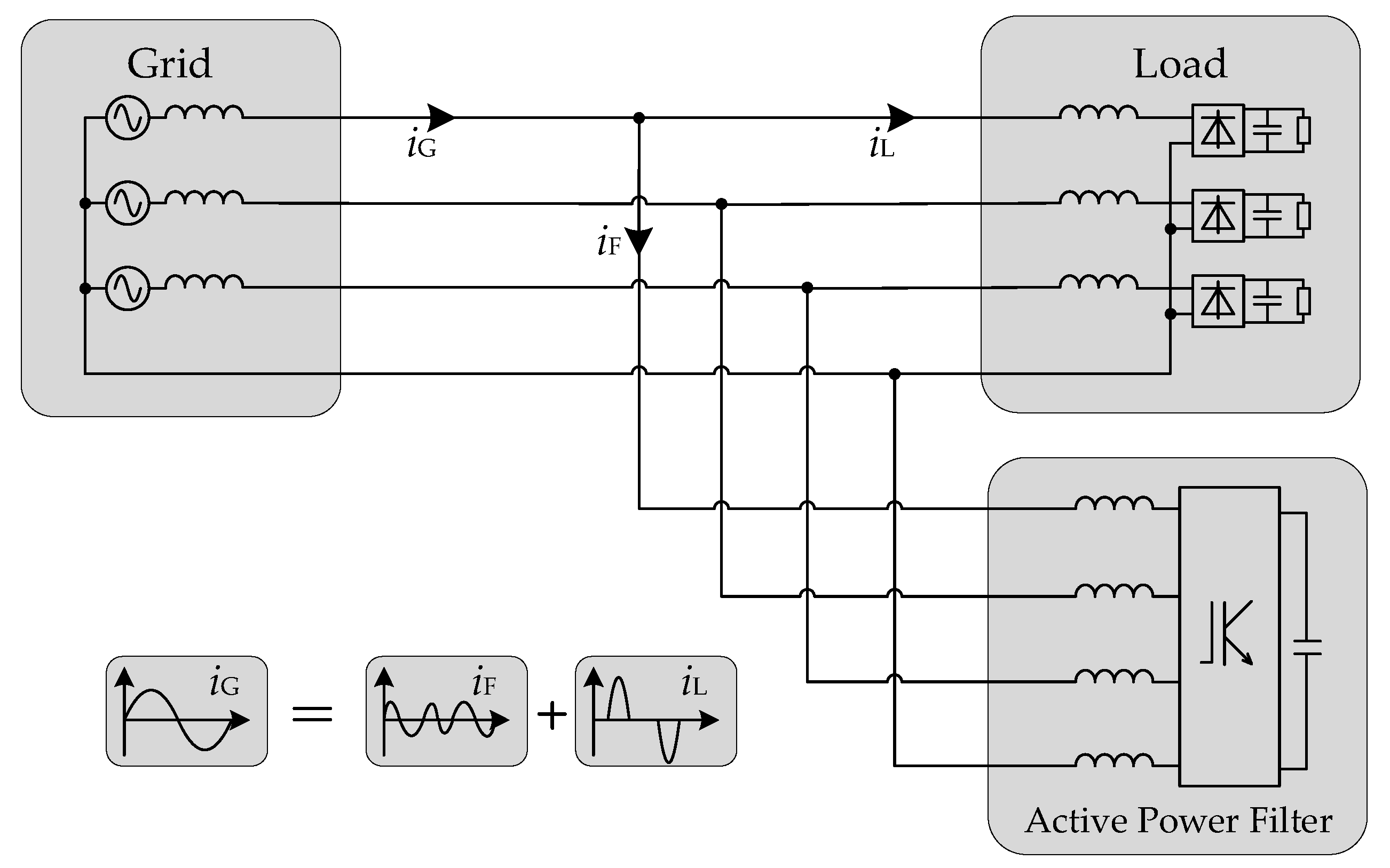


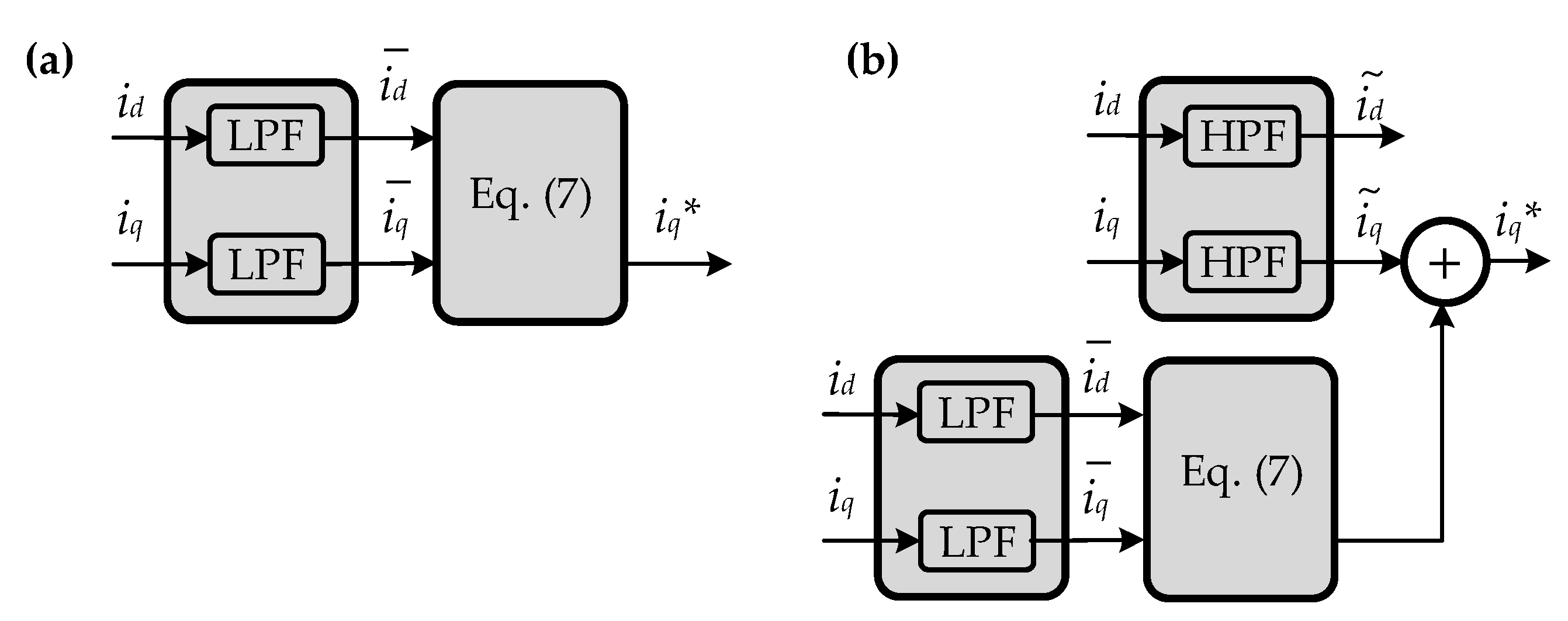
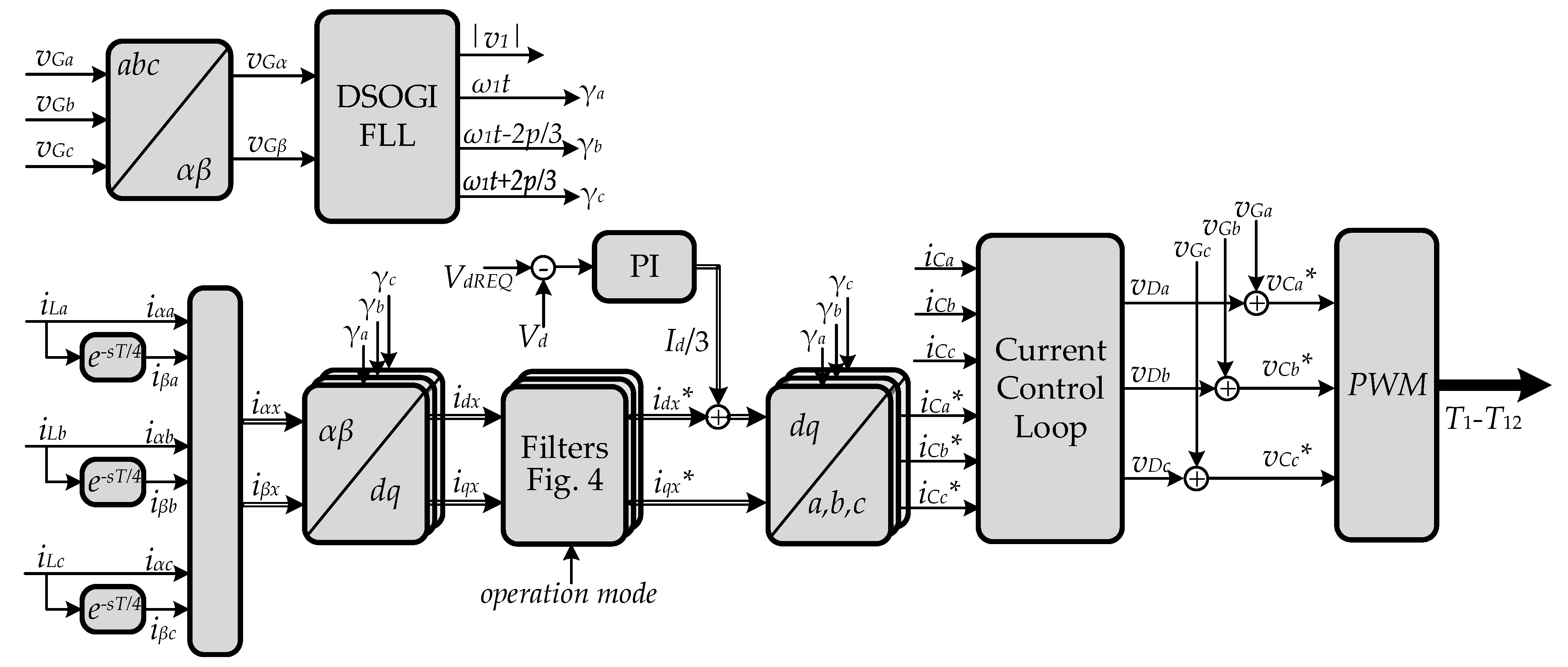
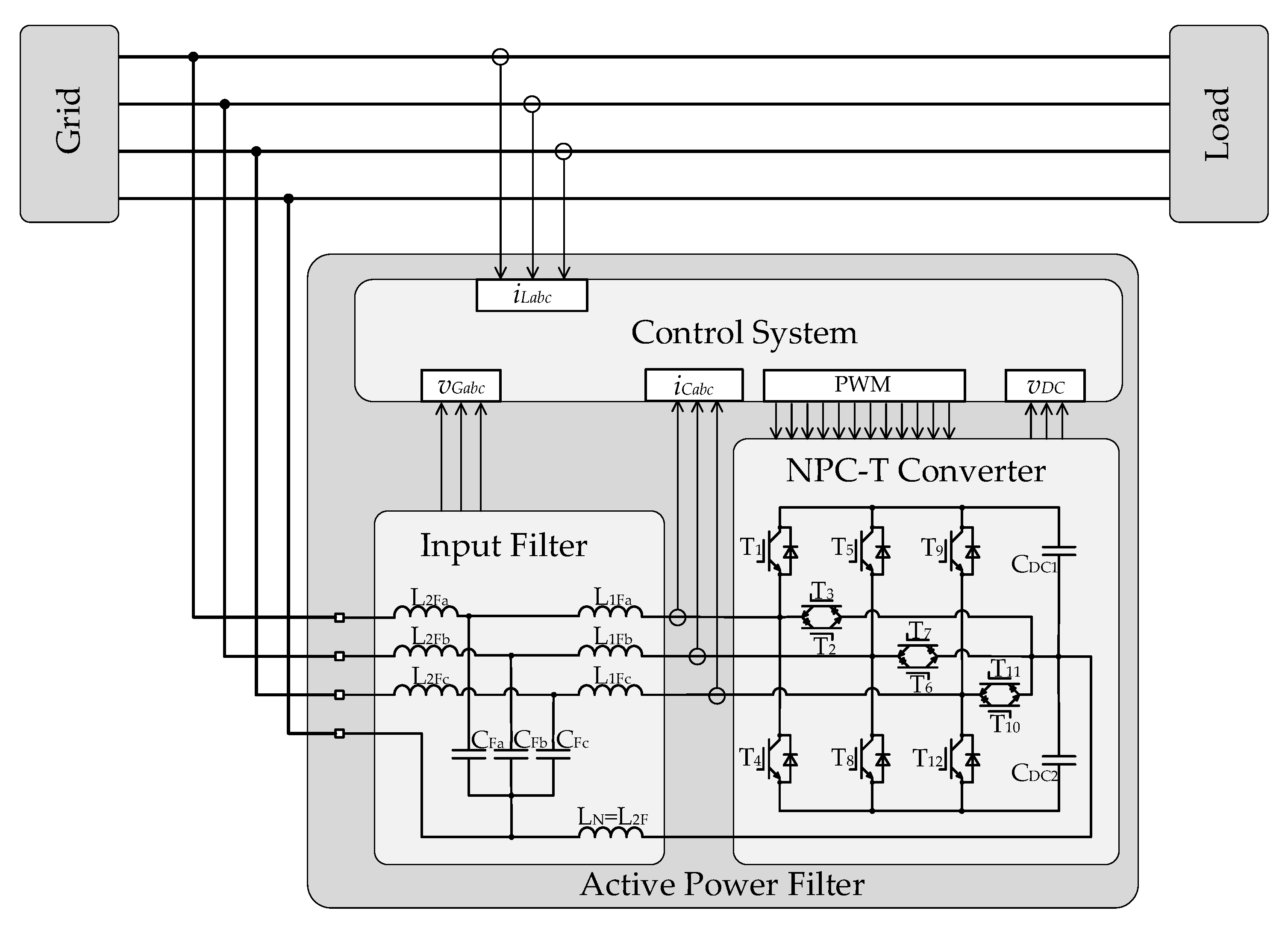



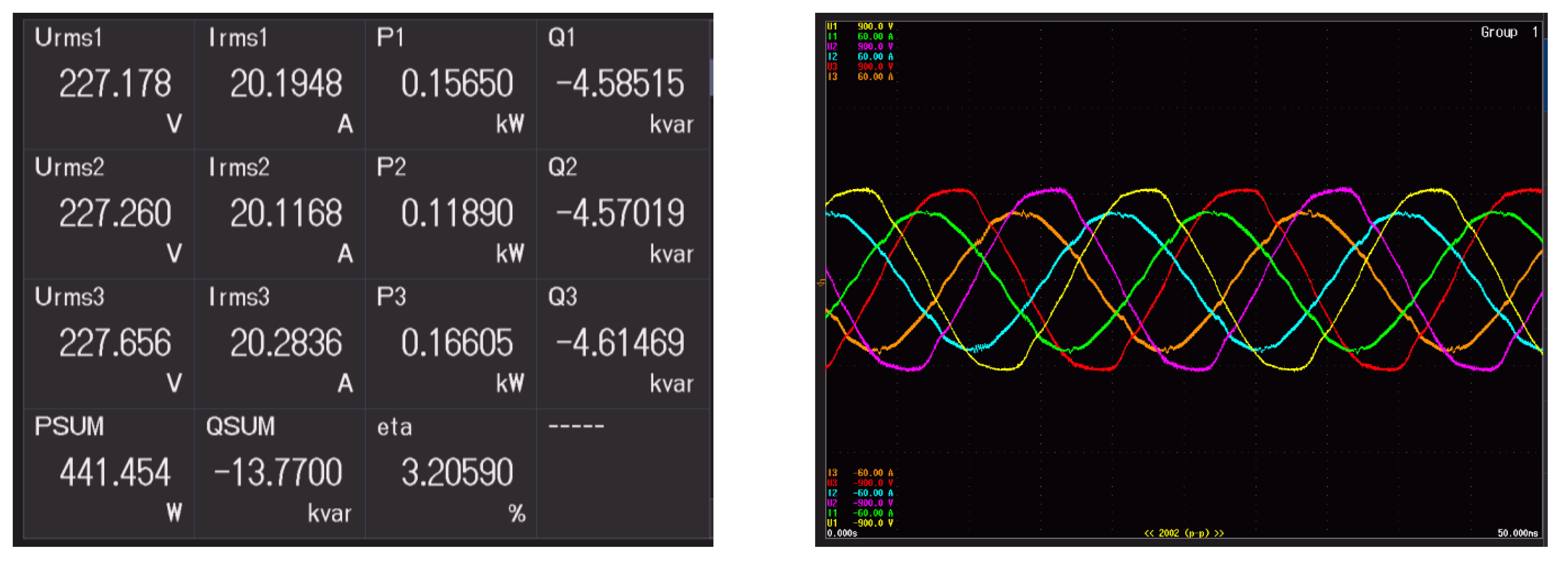

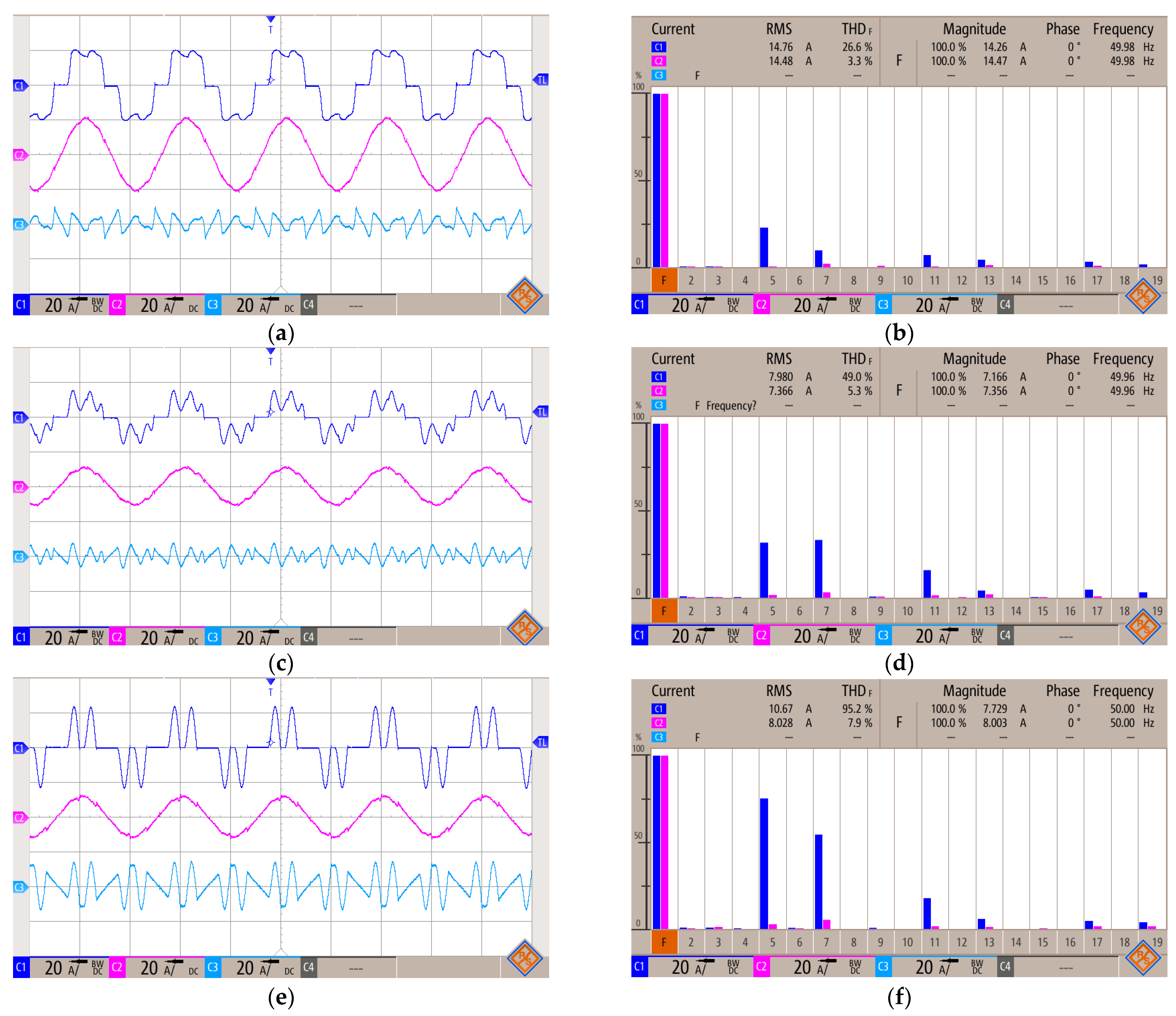
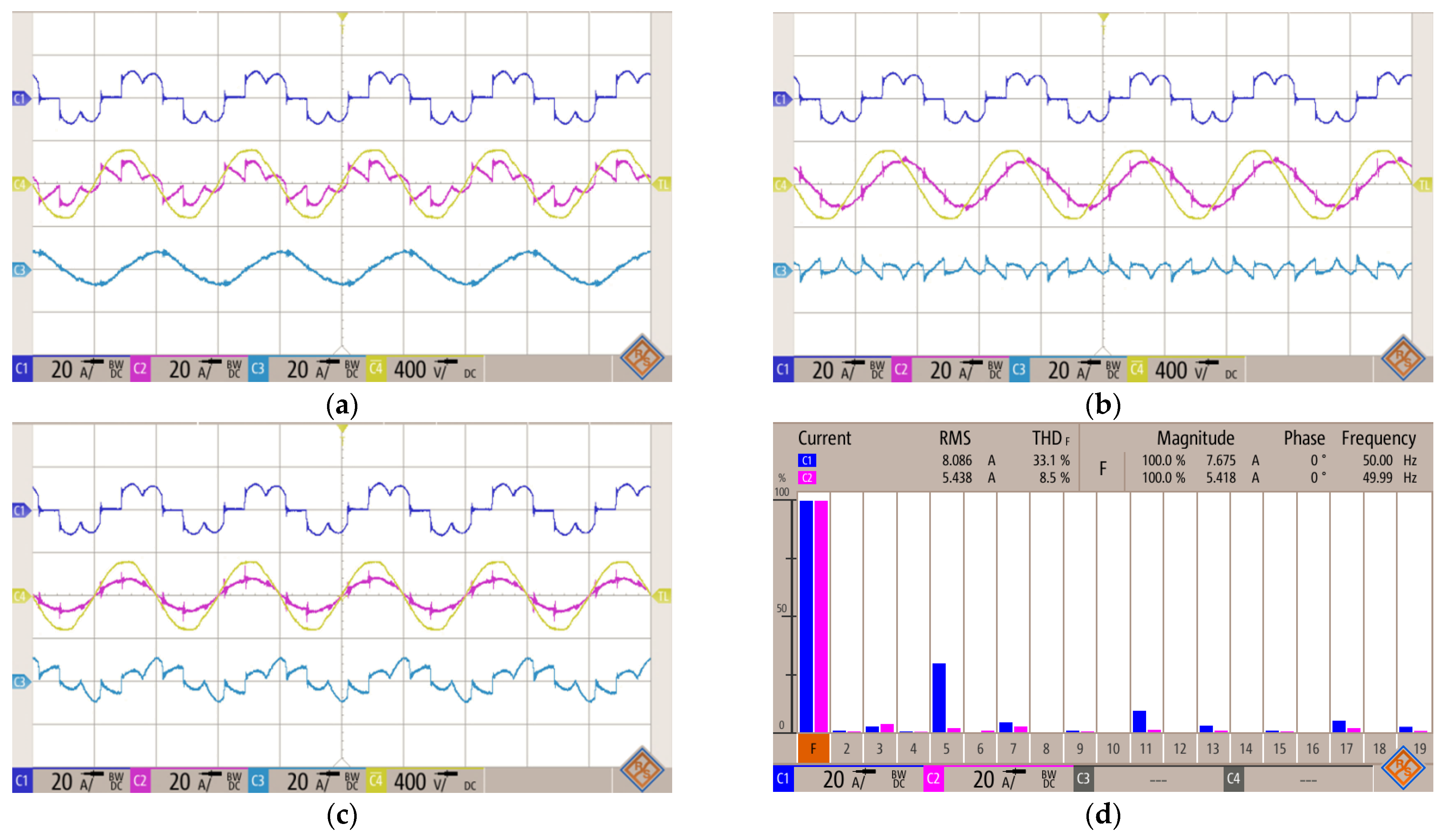
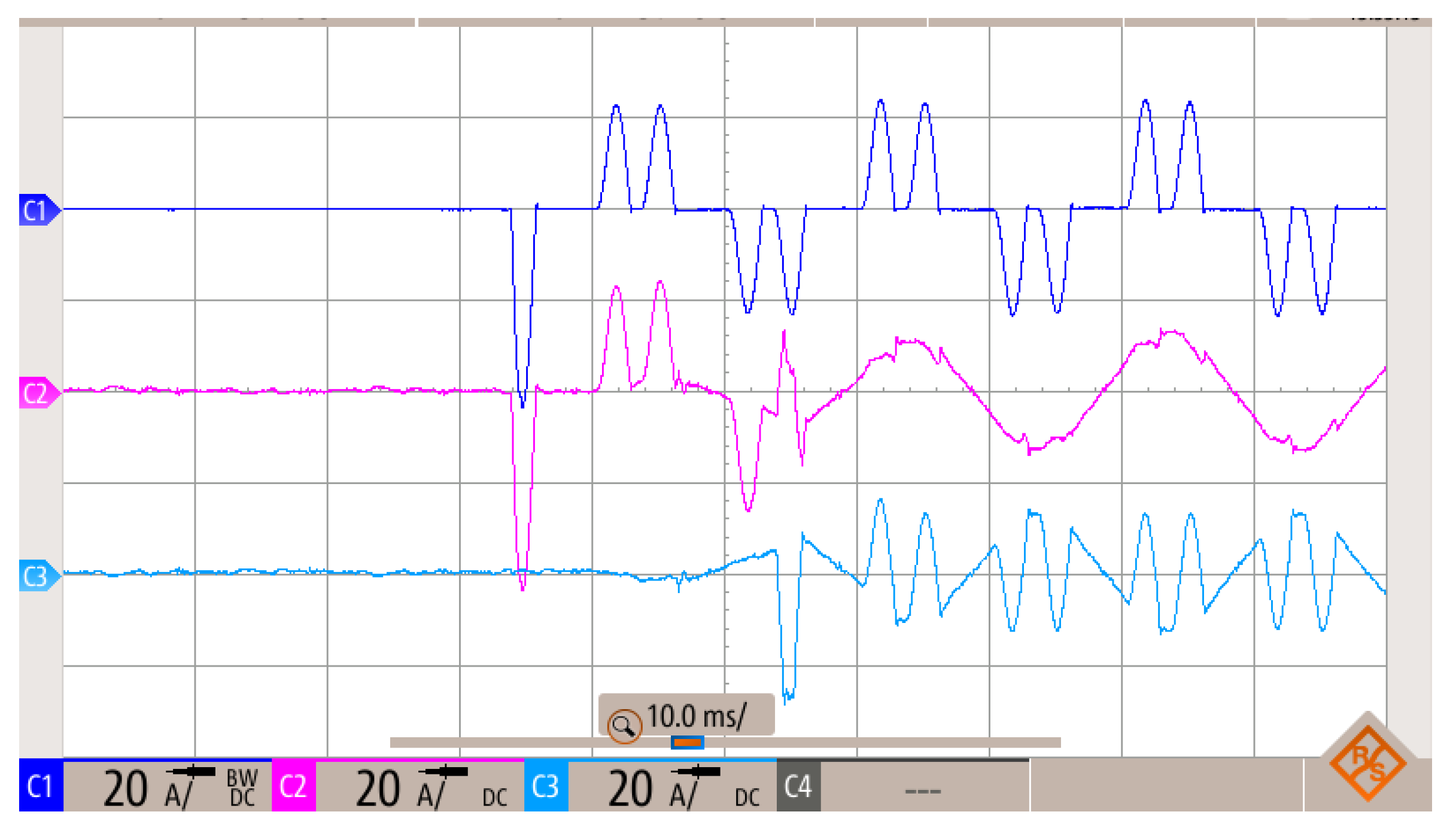
| Parameter | Description | Value |
|---|---|---|
| VN | Nominal line-to-line voltage RMS | 400 V |
| IN | Nominal phase current RMS | 20 A |
| VDCN | DC-link nominal voltage | 750 V |
| fsw | Switching frequency | 20 kHz |
| L1F | Converter side filter inductor | 0.75 mH |
| L2F | Grid side filter inductor | 0.15 mH |
| CF | Filter capacitor | 4.4 μF |
| CDC1, CDC2 | DC-link capacitor | 2 mF |
| Qgen, kvar | ILRMS, A | Ploss, W | Rloss, W/kvar |
|---|---|---|---|
| −13.8 | 20.2 | 441 | 32.0 |
| −11.0 | 16.1 | 327 | 29.7 |
| −8.2 | 12.1 | 236 | 28.8 |
| −5.4 | 7.9 | 162 | 29.9 |
| −2.7 | 4.0 | 102 | 38.0 |
| −0.8 | 1.1 | 74 | 97.7 |
| 0.2 | 0.4 | 72 | 287.3 |
| 0.7 | 1.0 | 76 | 104.2 |
| 2.8 | 4.1 | 113 | 40.6 |
| 5.4 | 8.0 | 173 | 31.9 |
| 8.2 | 12.2 | 257 | 31.2 |
| 10.9 | 16.1 | 345 | 31.6 |
| 13.5 | 20.0 | 447 | 33.2 |
Publisher’s Note: MDPI stays neutral with regard to jurisdictional claims in published maps and institutional affiliations. |
© 2021 by the authors. Licensee MDPI, Basel, Switzerland. This article is an open access article distributed under the terms and conditions of the Creative Commons Attribution (CC BY) license (https://creativecommons.org/licenses/by/4.0/).
Share and Cite
Buła, D.; Jarek, G.; Michalak, J.; Zygmanowski, M. Control Method of Four Wire Active Power Filter Based on Three-Phase Neutral Point Clamped T-Type Converter. Energies 2021, 14, 8427. https://doi.org/10.3390/en14248427
Buła D, Jarek G, Michalak J, Zygmanowski M. Control Method of Four Wire Active Power Filter Based on Three-Phase Neutral Point Clamped T-Type Converter. Energies. 2021; 14(24):8427. https://doi.org/10.3390/en14248427
Chicago/Turabian StyleBuła, Dawid, Grzegorz Jarek, Jarosław Michalak, and Marcin Zygmanowski. 2021. "Control Method of Four Wire Active Power Filter Based on Three-Phase Neutral Point Clamped T-Type Converter" Energies 14, no. 24: 8427. https://doi.org/10.3390/en14248427
APA StyleBuła, D., Jarek, G., Michalak, J., & Zygmanowski, M. (2021). Control Method of Four Wire Active Power Filter Based on Three-Phase Neutral Point Clamped T-Type Converter. Energies, 14(24), 8427. https://doi.org/10.3390/en14248427







